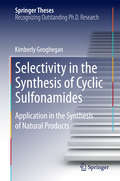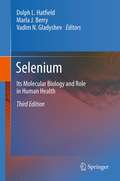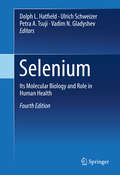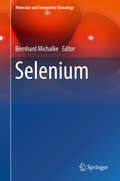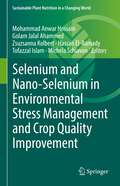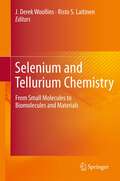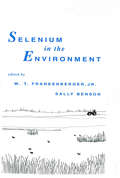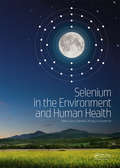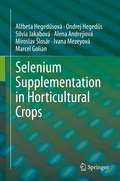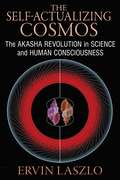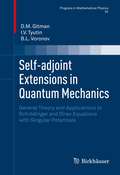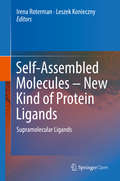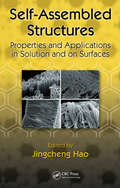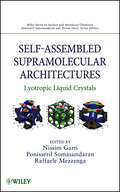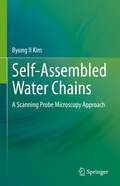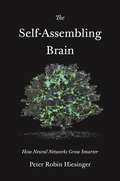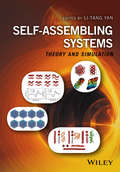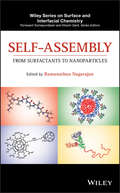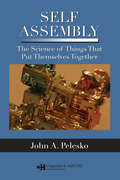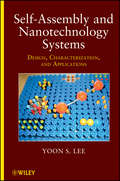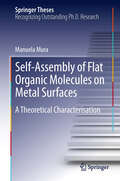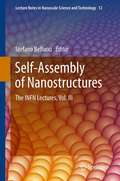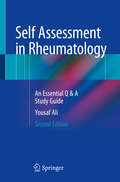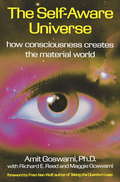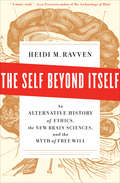- Table View
- List View
Selectivity in the Synthesis of Cyclic Sulfonamides
by Kimberly GeogheganIn the area of organic chemistry one major challenge we are currently faced with is how to assemble potentially useful molecules in new ways that generate molecular complexity and in sequences that are as efficient as possible. Our efforts in this regard, specifically for the preparation of amino containing compounds incorporating an aromatic ring, are described in this doctoral thesis. We discovered an interesting regioselectivity in an intramolecular Heck reaction, which we studied for a series of substrates that are unbiased in terms of the size of the newly formed ring, where very high levels of selectivity in relation to the new carbon-carbon bond are typically observed. DFT calculations were performed to attempt to shed light on the reaction sequence. This regioselective Heck reaction, combined with the reductive removal of the temporary amino-protecting group, allowed us to synthesize the Sceletium alkaloids: mesembrane, mesembranol and mesembrine.
Selenium
by Dolph L. Hatfield Vadim N. Gladyshev Marla J. BerryMany health benefits have been attributed to selenium that include preventing various forms of cancer (e.g., colon cancer, prostate cancer, lung cancer and liver cancer), heart disease and other cardiovascular and muscle disorders, inhibiting viral expression, delaying the progression of acquired immunodeficiency syndrome (AIDS) in human immunodeficiency virus (HIV)-positive patients, slowing the aging process, and having roles in mammalian development, including male reproduction and immune function. The purpose of the book is the same as the first two volumes which is to bring an up to date status of current research in the rapidly developing selenium field centered around the health benefits attributed to this element and how this element makes its way into protein.
Selenium
by Dolph L. Hatfield Ulrich Schweizer Petra A. Tsuji Vadim N. GladyshevAs discussed in this book, a large body of evidence indicates that selenium is a cancer chemopreventive agent. Further evidence points to a role of this element in reducing viral expression, in preventing heart disease, and other cardiovascular and muscle disorders, and in delaying the progression of AIDS in HIV infected patients. Selenium may also have a role in mammalian development, in male fertility, in immune function and in slowing the aging process. The mechanism by which selenium exerts its beneficial effects on health may be through selenium-containing proteins. Selenium is incorporated into protein as the amino acid selenocysteine. Selenocysteine utilizes a specific tRNA, a specific elongation factor, a specific set of signals, and the codeword, UGA, for its cotranslational insertion into protein. It is indeed the 21st naturally occurring amino acid to be incorporated into protein and marks the first and only expansion of the genetic code since the code was deciphered in the mid 1960s.
Selenium (Molecular and Integrative Toxicology)
by Bernhard MichalkeThis book summarizes the fast-growing and current knowledge about selenium interaction with cancer, diabetes, neuro-degeneration, heart disease, muscle disorders, HIV and several more. A special focus will be placed on in-depth knowledge about gene expression, selenoprotein biosynthesis, seleno-metabolism--as well as the molecular pathways, physiological roles, and the molecular action of selenium including interaction with other elements and vitamins or as Se-nanoparticles. The reader will receive the newest information regarding redox status and redox regulatory systems, specifically in relation to different glutathione peroxidases and thioredoxin-reductases as well as about cellular bioavailability and cytotoxicity, de-balanced immune response, inflammation or dietary aspects.
Selenium and Nano-Selenium in Environmental Stress Management and Crop Quality Improvement (Sustainable Plant Nutrition in a Changing World)
by Mohammad Anwar Hossain Golam Jalal Ahammed Zsuzsanna Kolbert Hassan El-Ramady Tofazzal Islam Michela SchiavonCrop plants growing under field conditions are constantly exposed to various abiotic and biotic stress factors leading to decreased yield and quality of produce. In order to achieve sustainable development in agriculture and to increase agricultural production for feeding an increasing global population, it is necessary to use ecologically compatible and environmentally friendly strategies to decrease the adverse effects of stresses on the plant. Selenium is one of the critical elements from the biological contexts because it is essential for human health; however, it becomes toxic at high concentrations. It has been widely reported that selenium can promote plant growth and alleviate various stresses as well as increase the quantity and quality of the yield of many plant species. Nonetheless, at high concentrations, selenium causes phytotoxicity. In the last decade, nanotechnology has emerged as a prominent tool for enhancing agricultural productivity. The production and applications of nanoparticles (NPs) have greatly increased in many industries, such as energy production, healthcare, agriculture, and environmental protection. The application of NPs has attracted interest for their potential to alleviate abiotic and biotic stresses in a more rapid, cost-effective, and more sustainable way than conventional treatment technologies. Recently, research related to selenium-NPs-mediated abiotic stresses and nutritional improvements in plants has received considerable interest by the scientific community. While significant progress was made in selenium biochemistry in relation to stress tolerance, an in-depth understanding of the molecular mechanisms associated with the selenium- and nano-selenium-mediated stress tolerance and bio-fortification in plants is still lacking. Gaining a better knowledge of the regulatory and molecular mechanisms that control selenium uptake, assimilation, and tolerance in plants is therefore vital and necessary to develop modern crop varieties that are more resilient to environmental stress. This book provides a comprehensive overview of the latest understanding of the physiological, biochemical, and molecular basis of selenium- and nano-selenium-mediated environmental stress tolerance and crop quality improvements in plants. It helps researchers to develop strategies to enhance crop productivity under stressful conditions and to better utilize natural resources to ensure future food security and to reduce environmental contamination. Finally, this book is a valuable resource for promoting future research into plant stress tolerance, and a reference book for researchers working on developing plants tolerant to abiotic and biotic stressors as well as bio-fortification and phytoremediation.
Selenium and Tellurium Chemistry
by J. Derek Woollins Risto LaitinenOur knowledge of the chemistry of selenium and tellurium has seen significant progress in the last few decades. This monograph comprises contributions from leading scientists on the latest research into the synthesis, structure and bonding of novel selenium and tellurium compounds. It provides insight into mechanistic studies of these compounds and describes coordination chemistry involving selenium and tellurium containing ligands. Contributions also describe the theoretical and spectroscopic studies of selenium and tellurium compounds. Additionally, this monograph outlines the applications of selenium and tellurium in biological systems, materials science and as reagents in organic synthesis and shows how these applications have been a fundamental driving force behind the research into the inorganic and organic chemistry these fascinating elements.
Selenium in the Environment (Books in Soils, Plants, and the Environment)
by W.T. Frankenberger Jr. Sally BensonDiscusses the biochemical and geological cycling of selenium (Se), its worldwide distribution, and the factors controlling its fate and transport within and between major environmental media, presenting a global assessment of selenium's complex environmental behaviour. The focus of this work is upon Se management and remediation strategies.
Selenium in the Environment and Human Health
by G. S. Bañuelos Z. Q. Lin Xuebin YinSelenium is arguably the naturally occurring trace element of greatest concern worldwide. In excessive amounts it can lead to toxicosis and teratogenesis in animals, while the impact of selenium deficiency can be even more significant. Contributors from 22 countries explored the connections and inter-relationships between selenium in the environmen
Selenium Supplementation in Horticultural Crops
by Alžbeta Hegedűsová Ondrej Hegedűs Silvia Jakabová Alena Andrejiová Miroslav Šlosár Ivana Mezeyová Marcel GolianSelenium plays a significant role in preventing certain types of cancer and cardiovascular diseases. The level of Selenium in the human body depends on its concentration in food. In turn, the content in vegetable crops is a function of the soil-plant system. There are many countries in the world with low Selenium content in the soil. The average daily human intake is thus limited through food chain. Analysis of Selenium status suggests that fortification of the soil substrate with Sodium Selenate, and foliar application to agricultural crops are both effective means of Selenium enrichment. Our intention for this publication is to present the possibilities of augmenting Selenium content by biofortification of soils and plants through differentiated nutrition. In the first part of the monograph, the results of Selenium supplementation in model vegetation experiments are presented. The next part of the monograph presents the results of foliar supplementation of Selenium in field conditions. This book is an outstanding reference source for plant breeders and researchers engaged in biofortification of horticulture crops. It is also beneficial to agricultural companies and other stakeholders.
The Self-Actualizing Cosmos: The Akasha Revolution in Science and Human Consciousness
by Ervin LaszloAn exploration of the current revolution in scientific thought and the newest scientific findings in support of the Akashic field • Explains how the new Akasha paradigm recognizes the interconnection of all things in space and time through the quantum resonance of the Akashic field • Reveals the cosmos to be a self-actualizing, self-organizing whole, bringing forth life and consciousness in countless universes • Explores the latest discoveries in the sciences of life, mind, and cosmos Science evolves through alternating phases of “normal science” and radical shifts that create scientific revolutions. We saw this at the turn of the 20th century, when science shifted from a Newtonian worldview to Einstein’s relativity paradigm, and again with the shift to the quantum paradigm. Now, as we recognize the nonlocal interconnection of all things in space and time, we find our scientific worldview shifting once again. With contributions by physicists Paul A. LaViolette and Peter Jakubowski, pioneering systems scientist Ervin Laszlo explores the genesis of the current revolution in scientific thought and the latest findings in support of the Akashic field. He explains how the burgeoning Akasha paradigm returns our way of thinking to an integral consciousness, a nonlinear mode of understanding that enables us to accept the reality of nonlocal interconnection throughout the world. This new inclusive way of understanding reaffirms the age-old instinctive comprehension of deep connections among people, societies, and nature, and it integrates and transcends classical religious and scientific paradigms. Providing examples from cutting-edge science of quantum-resonance-based interactions among all living systems, Laszlo shows the cosmos of the Akasha to be a self-actualizing, self-organizing whole, where each part is in coherence with all others and all parts together create the conditions for the emergence of life and consciousness. The advent of the Akasha paradigm marks a new stage in science’s understanding of the fundamental nature of the world and offers unique guidance for contemporary efforts to create a peaceful and sustainable world.
Self-adjoint Extensions in Quantum Mechanics
by I. V. Tyutin D. M. Gitman B. L. VoronovThis exposition is devoted to a consistent treatment of quantization problems, based on appealing to some nontrivial items of functional analysis concerning the theory of linear operators in Hilbert spaces. The authors begin by considering quantization problems in general, emphasizing the nontriviality of consistent operator construction by presenting paradoxes to the naive treatment. It then builds the necessary mathematical background following it by the theory of self-adjoint extensions. By considering several problems such as the one-dimensional Calogero problem, the Aharonov-Bohm problem, the problem of delta-like potentials and relativistic Coulomb problemIt then shows how quantization problems associated with correct definition of observables can be treated consistently for comparatively simple quantum-mechanical systems. In the end, related problems in quantum field theory are briefly introduced. This well-organized text is most suitable for students and post graduates interested in deepening their understanding of mathematical problems in quantum mechanics. However, scientists in mathematical and theoretical physics and mathematicians will also find it useful.
Self-Assembled Molecules – New Kind of Protein Ligands: Supramolecular Ligands
by Leszek Konieczny Irena RotermanThe subject of this book relates to protein ligands with particular structural and complexation properties. They are composed of self-assembled molecules, capable of penetrating as a unit into proteins outside the binding site. The ribbon-like supramolecular system only permits the penetration of self-assembled molecules into the protein-body and formation of stable complexes. Supramolecular Congo red and similar compounds fit these requirements. Destabilized protein fragments enable the penetration of such ligands, with susceptibility to supramolecular ligand binding often associated with protein function. As a result, complexation modifies their functional effects. The activity of enzymes is inhibited by arresting them in the complexed state, but "naturally irreversible" complexation as in the case of immune complexation, is enhanced instead. This property offers many attractive possibilities of using supramolecular ligands as described in this book. This book is an open access under a CC BY license.
Self-Assembled Structures: Properties and Applications in Solution and on Surfaces
by Jingcheng HaoSelf-assembly is a process in which a disordered system forms an organized structure without external direction. Examples include the formation of molecular crystals, lipid bilayers, and polymer brushes. This book reviews the fabrication and use of various self-assembled materials. In particular, the author pays special attention to self-assembled structures when in solution and in contact with surfaces, as such interactions can have a pronounced impact on their properties and applications. The text covers bulk solution and surfaces, assembled structures, colloid particles, polymer capsules, carbon nanotubes, as well as layer-by-layer assembly techniques.
Self-Assembled Supramolecular Architectures
by Nissim GartiThis book will describe fundamentals and recent developments in the area of Self-Assembled Supramolecular Architecture and their relevance to the understanding of the functionality of membranes as delivery systems for active ingredients. As the heirarchial architectures determine their performance capabilities, attention will be paid to theoretical and design aspects related to the construction of lyotropic liquid crystals: mesophases such as lamellar, hexagonal, cubic, sponge phase micellosomes. The book will bring to the reader mechanistic aspects, compositional considerations, transition within phases, solubilization capacities, drug entrapment and release mechanisms and transmembrane, transdermal, and other transport phenomena. It will stress the importance of these mesostructures to crystallization and polymorphism of drugs, fats, and nutraceuticals and will discuss regioselectivity of organic and enzymatic reactions that take place at interfaces and within the channels of the mesophase. The book will bring studies on the use of these mesophase as crystallization or particulation media for the formation of nanoparticles and nanocrystals. Chapters will discuss applications in the areas of pharmaceuticals, food, cosmetics, plastics, paper, agro-chemistry and industrial applications.
Self-Assembled Water Chains: A Scanning Probe Microscopy Approach
by Byung Il KimDespite advances in the long-range electrostatic double-layer force, which depends strongly on ionic strength in water by using theoretical models such as DLVO (Derjaguin, Landau, Verwey, and Overbeek), the structure of confined water in air still remains widely unknown and has led to a variety of unexplained phenomena. This book bridges that gap by introducing a newly developed scanning probe miscroscopy (SPM) approach, which enables one to probe confined water at the molecular and atomic scale. Written by the developer of SPM, this book covers this new approach, as well as original approaches to addressing general interfacial water issues. It also introduces the cantilever-based optical interfacial force microscope (COIFM), which was invented by the author along with the methodology. The improved understanding will contribute to liquid-based nano- and bio-technologies such as lab-on-a-chip technologies, nanofluidic devices, dip-pen nanolithography, nano-oxidation, water-based granular interactions, liquid-based nanolubricants, hydration layers in biopolymers, manipulation of biomolecules, protein folding, stability of colloid suspensions, enzyme activity, swelling in clays, development of bioactive surfaces, water columns and ion channeling in membranes and scanning probe microscopy (SPM). It will also contribute to the improved performance of moving components in silicon-based micro-electro-mechanical system (MEMS) devices, where water plays a key role in interfacial interactions.
The Self-Assembling Brain: How Neural Networks Grow Smarter
by Peter Robin HiesingerWhat neurobiology and artificial intelligence tell us about how the brain builds itself How does a neural network become a brain? While neurobiologists investigate how nature accomplishes this feat, computer scientists interested in artificial intelligence strive to achieve this through technology. The Self-Assembling Brain tells the stories of both fields, exploring the historical and modern approaches taken by the scientists pursuing answers to the quandary: What information is necessary to make an intelligent neural network?As Peter Robin Hiesinger argues, “the information problem” underlies both fields, motivating the questions driving forward the frontiers of research. How does genetic information unfold during the years-long process of human brain development—and is there a quicker path to creating human-level artificial intelligence? Is the biological brain just messy hardware, which scientists can improve upon by running learning algorithms on computers? Can AI bypass the evolutionary programming of “grown” networks? Through a series of fictional discussions between researchers across disciplines, complemented by in-depth seminars, Hiesinger explores these tightly linked questions, highlighting the challenges facing scientists, their different disciplinary perspectives and approaches, as well as the common ground shared by those interested in the development of biological brains and AI systems. In the end, Hiesinger contends that the information content of biological and artificial neural networks must unfold in an algorithmic process requiring time and energy. There is no genome and no blueprint that depicts the final product. The self-assembling brain knows no shortcuts.Written for readers interested in advances in neuroscience and artificial intelligence, The Self-Assembling Brain looks at how neural networks grow smarter.
Self-Assembling Systems: Theory and Simulation
by Li-Tang YanProvides comprehensive knowledge on concepts, theoretical methods and state-of-the-art computational techniques for the simulation of self-assembling systems Looks at the field of self-assembly from a theoretical perspective Highlights the importance of theoretical studies and tailored computer simulations to support the design of new self-assembling materials with useful properties Divided into three parts covering the basic principles of self-assembly, methodology, and emerging topics
Self-Assembly: From Surfactants to Nanoparticles (Wiley Series on Surface and Interfacial Chemistry)
by Ramanathan NagarajanAn introduction to the state-of-the-art of the diverse self-assembly systems Self-Assembly: From Surfactants to Nanoparticles provides an effective entry for new researchers into this exciting field while also giving the state of the art assessment of the diverse self-assembling systems for those already engaged in this research. Over the last twenty years, self-assembly has emerged as a distinct science/technology field, going well beyond the classical surfactant and block copolymer molecules, and encompassing much larger and complex molecular, biomolecular and nanoparticle systems. Within its ten chapters, each contributed by pioneers of the respective research topics, the book: Discusses the fundamental physical chemical principles that govern the formation and properties of self-assembled systems Describes important experimental techniques to characterize the properties of self-assembled systems, particularly the nature of molecular organization and structure at the nano, meso or micro scales. Provides the first exhaustive accounting of self-assembly derived from various kinds of biomolecules including peptides, DNA and proteins. Outlines methods of synthesis and functionalization of self-assembled nanoparticles and the further self-assembly of the nanoparticles into one, two or three dimensional materials. Explores numerous potential applications of self-assembled structures including nanomedicine applications of drug delivery, imaging, molecular diagnostics and theranostics, and design of materials to specification such as smart responsive materials and self-healing materials. Highlights the unifying as well as contrasting features of self-assembly, as we move from surfactant molecules to nanoparticles. Written for students and academic and industrial scientists and engineers, by pioneers of the research field, Self-Assembly: From Surfactants to Nanoparticles is a comprehensive resource on diverse self-assembly systems, that is simultaneously introductory as well as the state of the art.
Self Assembly: The Science of Things That Put Themselves Together
by John A. PeleskoHailed as one of the key areas of nanoscience likely to shape future scientific research, self-assembly offers the most promising route to true molecular nanotechnology. Focusing on this dynamic new field, Self Assembly: The Science of Things That Put Themselves Together explores nature's self-assembly of structures, the use of it to build engineer
Self-assembly and nanotechnology systems: design, characterization, and applications
by Yoon S. LeeA fundamental resource for understanding and developing effective self-assembly and nanotechnology systems Systematically integrating self-assembly, nanoassembly, and nanofabrication into one easy-to-use source, Self-Assembly and Nanotechnology Systems effectively helps students, professors, and researchers comprehend and develop applicable techniques for use in the field. Through case studies, countless examples, clear questions, and general applications, this book provides experiment-oriented techniques for designing, applying, and characterizing self-assembly and nanotechnology systems. Self-Assembly and Nanotechnology Systems includes: Techniques for identifying assembly building units Practical assembly methods to focus on when developing nanomaterials, nanostructures, nanoproperties, nanofabricated systems, and nanomechanics Algorithmic diagrams in each chapter for a general overview Schematics designed to link assembly principles with actual systems Hands-on lab activities This informative reference also analyzes the diverse origins and structures of assembly building units, segmental analysis, and selection of assembly principles, methods, characterization techniques, and predictive models. Complementing the author's previous conceptually based book on this topic, Self-Assembly and Nanotechnology Systems is a practical guide that grants practitioners not only the skills to properly analyze assembly building units but also how to work with applications to exercise and develop their knowledge of this rapidly advancing scientific field.
Self-Assembly of Flat Organic Molecules on Metal Surfaces
by Manuela MuraManuela Mura's thesis is devoted to ab initio studies of self-assembled organic molecules on a gold surface. This area of research is particularly vibrant because of the various applications such studies have in nanoscience and surface chemistry and physics. In this thesis Manuela Mura uses theory to suggest atomistic models for the observed assembled and she proposes an assembly mechanism. The methods and results developed as part of this work will be of wide interest to physicists and chemists working on the assemblies of organic molecules on crystal surfaces.
Self-Assembly of Nanostructures
by Stefano BellucciThis is the third volume in a series of books on selected topics in Nanoscale Science and Technology based on lectures given at the well-known Istituto Nazionale di Fisica Nucleare (INFN) schools of the same name. The present set of notes stems in particular from the participation and dedication of prestigious lecturers, such as Nunzio Motta, Fulvia Patella, Alexandr Toropov, and Anna Sgarlata. All lectures have been carefully edited and reworked, taking into account extensive follow-up discussions. A tutorial lecture by Motta et al. presents the analysis of the Poly(3-hexylthiophene) self assembly on carbon nanotubes and discusses how the interaction between the two materials forms a new hybrid nanostructure, with potential application to future solar cells technology. In their contribution, Patella et al. review quantum dots of III-V compounds, which offer appealing perspectives for more sophisticated applications in new generation devices such as single-photon emitters for nano-photonics and quantum computing. Focusing on self-assembled quantum dots, the chapter by Alexandr Toropov et al. provides a comprehensive review of some important aspects in the formation of quantum dots and presents the results of the authors' extensive investigation of the features of droplet epitaxy. The fourth contribution, by Sgarlata et al., focuses on recent progress toward controlled growth of self-assembled nanostructures, dealing with the shaping, ordering and localization in Ge/Si heteroepitaxy and reviewing recent results on the self-organization of Ge nanostructures at Si surfaces.
Self Assessment in Rheumatology: An Essential Q & A Study Guide
by Yousaf AliThis practical study guide illustrates a variety of different scenarios of rheumatic disease in succinct question and answer format. It contains 120 complex cases with potentially unusual diagnoses designed to stimulate thought and further reading in this rapidly evolving specialty. The questions demonstrate both common and uncommon rheumatologic conditions that may be encountered on ward rounds or in clinic by using radiographs, pictures, and skin findings. Each case is based on a real-life diagnostic situation encountered by the author from his two decades of experience working in a busy consultative practice.Self Assessment in Rheumatology: An Essential Q & A Study Guide, Second Edition is an essential resource for students, postgraduate fellows, internists, and practicing physicians eager to learn more about rheumatology, test their fund of knowledge, or prepare for board examinations.
The Self-Aware Universe
by Amit GoswamiConsciousness, not matter, is the ground of all existence, declares University of Oregon physicist Goswami, echoing the mystic sages of his native India. He holds that the universe is self-aware, and that consciousness creates the physical world.
The Self Beyond Itself: An Alternative History of Ethics, the New Brain Sciences, and the Myth of Free Will
by Heidi M. Ravven&“Intertwines history, philosophy, and science . . . A powerful challenge to conventional notions of individual responsibility&” (Publishers Weekly). Few concepts are more unshakable in our culture than free will, the idea that individuals are fundamentally in control of the decisions they make, good or bad. And yet the latest research about how the brain functions seems to point in the opposite direction . . . In a work of breathtaking intellectual sweep and erudition, Heidi M. Ravven offers a riveting and accessible review of cutting-edge neuroscientific research into the brain&’s capacity for decision-making—from &“mirror&” neurons and &“self-mapping&” to surprising new understandings of group psychology. The Self Beyond Itself also introduces readers to a rich, alternative philosophical tradition of ethics, rooted in the writing of Baruch Spinoza, that finds uncanny confirmation in modern science. Illustrating the results of today&’s research with real-life examples, taking readers from elementary school classrooms to Nazi concentration camps, Ravven demonstrates that it is possible to build a theory of ethics that doesn&’t rely on free will yet still holds both individuals and groups responsible for the decisions that help create a good society. The Self Beyond Itself is that rare book that injects new ideas into an old debate—and &“an important contribution to the development of our thinking about morality&” (Washington Independent Review of Books). &“An intellectual hand-grenade . . . A magisterial survey of how contemporary neuroscience supports a vision of human morality which puts it squarely on the same plane as other natural phenomena.&” —William D. Casebeer, author of Natural Ethical Facts
